KoyaQuest
Kōyasan Events

Kōyasan Events

Kōyasan Events
As an active monastery with over 100 temples, the yearly calendar at Kōyasan is replete with a number of colorful ceremonies and solemn observations. The following is an abridged list of the major services that a visitor is likely to encounter.
All dates/times are local.
Current time is Saturday, May 17, 2025 (16:13)

A three-day exoteric ritual for peace, prosperity and protection during the new year.
Since the eighth century, Buddhist temples in Japan have marked the start of the new year with disciplinary rites through which the repentance of sins will help ensure domestic tranquility, a bountiful harvest (of the “five grains”) and protection from natural disasters. The name Shushō-e may be translated as "Gathering for the Promotion of Correct Conduct."
The highlight of the ceremony features the assembly of priests rapping at the floor three times with wooden staffs known as go-ōzue. This action is intended to comfort the spirits of the dead, revive the latent energies of the earth and drive away any subterranean demons that may be about. At the conclusion of the three-day observance, congregants and visitors are given protective amulets (o-mamori) and their own good-luck staff (fukuzue) which can be taken home and placed on a family altar. The service at the Kondō is conducted in accordance with exoteric Buddhist procedures while that at the Daitō is an esoteric rite.

A three-day exoteric ritual for peace, prosperity and protection during the new year.
Since the eighth century, Buddhist temples in Japan have marked the start of the new year with disciplinary rites through which the repentance of sins will help ensure domestic tranquility, a bountiful harvest (of the “five grains”) and protection from natural disasters. The name Shushō-e may be translated as "Gathering for the Promotion of Correct Conduct."
The highlight of the ceremony features the assembly of priests rapping at the floor three times with wooden staffs known as go-ōzue. This action is intended to comfort the spirits of the dead, revive the latent energies of the earth and drive away any subterranean demons that may be about. At the conclusion of the three-day observance, congregants and visitors are given protective amulets (o-mamori) and their own good-luck staff (fukuzue) which can be taken home and placed on a family altar.

An exoteric ritual for peace, prosperity and protection during the new year.
Since the eighth century, Buddhist temples in Japan have marked the start of the new year with disciplinary rites through which the repentance of sins will help ensure domestic tranquility, a bountiful harvest (of the “five grains”) and protection from natural disasters. The name Shushō-e may be translated as Gathering for the Promotion of Correct Conduct.
The highlight of the ceremony features the assembly of priests rapping at the floor three times with wooden staffs known as go-ōzue. This action is intended to comfort the spirits of the dead, revive the latent energies of the earth and drive away any subterranean demons that may be about. At the conclusion of the three-day observance, congregants and visitors are given protective amulets (o-mamori) and their own good-luck staff (fukuzue) which can be taken home and placed on a family altar.

A Buddhist service in remembrance of the more than six thousand victims of the 1996 earthquake.
On January 17, 1995, the southern part of Hyogo Prefecture was hit by a 6.9 magnitude earthquake. The tremors and the ensuing fires killed an estimated 6,434 people, mostly in the city of Kobe.
In 1996, a cenotaph for the victims was erected at Kōyasan's Oku-no-in. Except for years when it has been held at Kongōbuji Temple, a memorial service has been conducted at the cenotaph annually on the anniversary of the disaster. After the reading of a sutra, attendees offer incense and prayers for the dead.
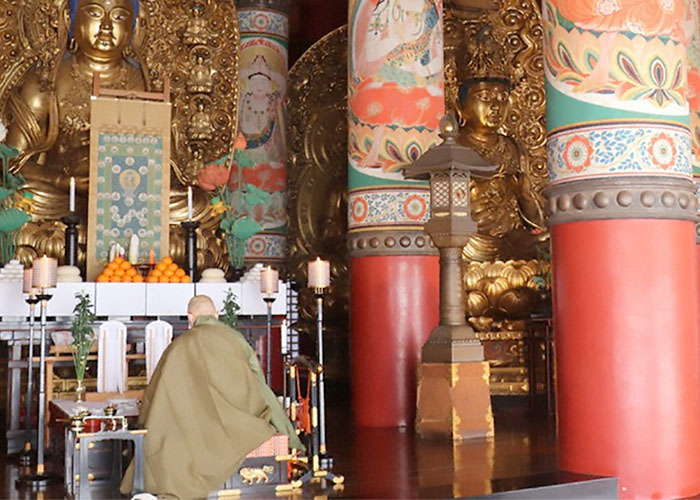
A worship service to mark the beginning of the new year according to the traditional calendar.
Setsubun is an annual observance held on the third of February to mark the end of the old year and the beginning of the new according to the traditional calendar. Meaning "seasonal cusp," it is the day before the traditional start of spring (risshun). The playful custom of throwing roasted beans to drive off evil spirits is practiced both at temples and shrines as well as ordinary households.
At Kōyasan a more solemn service is conducted at the Konpon Daitō with particular focus on the various constellations of the Chinese zodiac thought to influence the fortunes of humans. For this reason it is sometimes referred to as the star festival. As with all Setsubun celebrations, however, the goal is to drive away bad fortune and welcome good.
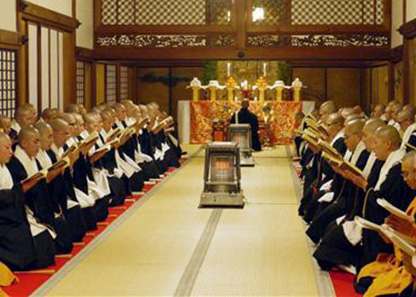
An annual vigil commemorating the death of the historical Buddha.
The Buddhist religion was founded in India in the 5th century B.C.E. by a former prince named Siddhartha Gautama, who abandoned his royalty to pursue a true understanding of the nature of existence. After achieving spiritual awakening, he became known as Shākyamuni, "The Sage of the Shakya" (after the name of his kingdom). After a lifetime of teaching, Shākyamuni died at the age of 80 on the fifteenth day of the second month. This event is commemorated annually on this day by gatherings known in Japan as Nehan-e or Nirvana Assemblies, as it marks Shākyamuni's passing into this state of final enlightenment. He is now regarded as the historical Buddha.
At Kōyasan, the Nehan-e is referred to as the Jōraku-e – jōraku being another name for this state of enlightenment. The Jōraku-e, which is one of the lengthiest services at Kōyasan, begins on the eve of the anniversary of Shākyamuni's death and lasts until about noon of the following day. This night-long vigil features the rhythmic chanting of sutras for the commemoration of his life, remembrance of his blessings, and veneration of his teachings. Four separate discourses (kō 講) are delivered. The first, beginning around 1:00 AM, is the Nehan-kō, which mourns the passing of Shākyamuni. The next is the Arhat Homily, or Rakan-kō, which celebrates his blessings and virtues and concludes near the break of day. After a pause for rest and meals, the priests (now joined by students and novices) reassemble for the final two discourses: the Yuiseki-kō and the Shari-kō which express, respectively, adoration for Shākyamuni's distant homeland and his holy relics.

A solemn ritual marking the installation of the new head priest.
Each year, a senior priest is appointed Hōin 法印 ("Dharma Seal"), which is the highest ceremonial post at Kōyasan. During his one-year term, the Hōin will remain on the mountain to serve as Kōbō Daishi's ritual surrogate and preside over the most important rites on the liturgical calendar. Literally translated as "the robe changing rite," the Hōin Ten'neshiki is the formal investiture for the new holder of this venerable office. The year 2024 will see the installation of the 525th priest to hold this title.
Before a large gathering of priests of all ranks, the new Hōin, dressed in his emblematic scarlet robes, takes his place on an elevated platform in the Ōhiroma of Kongōbuji Temple. Offerings of rice and konbu seaweed are made before him. After these offerings, the senior clergy solemnly kneel before the new Hōin signifying his new, exalted status. He departs through the most prestigious of the temple's entryways and is carried away in a black and red palanquin.

A Shugendō rite to usher in the arrival of spring.
Shugendō 修験道 is an ascetic religion founded by a seventh-century mystic named En no Gyōja 役行者 (634-c.707). Incorporating elements of Buddhism and Shinto, this sect stresses the development of supernatural powers through rigorous training in remote mountain areas, accordingly, its practitioners are called Yamabushi 山伏 (literally, "those who lie in the mountains"). Its members are recognizable by their straw sandals, pom-pom decorated surplices, the box-shaped ornaments worn on their foreheads and the large conch shells that they carry. While the religion is practiced throughout Japan, one of their major centers is Mt. Ōmine, located 30km to the east of Kōyasan.
The Kōya Fire Festival, more formally known as the Saitō Ōgoma-ku 柴燈大護摩供, is a ritual unique to the Shugendō sect. The aim is to usher in the arrival of spring by warding off evil and summoning the blessings of gods and buddhas. Specifically, the rite is intended to drive out the "seven calamities" and summon the "seven sources of happiness." It has been conducted annually at Kōyasan since 1996. Beginning with a procession that includes the chief priest of Kongōbuji Temple, the Yamabushi encircle a pyre (gomadan 護摩壇) of pine branches. A swordsman and archer perform ritual incantations and the bonfire is lit. As the fire burns, sutras are chanted. After the fire, protective amulets are distributed to those in attendance.

A ritual blessing or "empowerment" of the robes presented to Kōbō Daishi.
This event is a critical prelude to the celebrations commemorating Kūkai's death and entry into perpetual meditation. Its origins go back to the tenth century when Kūkai, who had passed away 86 years earlier, appeared in a dream to Emperor Daigo 醍醐 (885-930) and recited a poem lamenting his condition: "in the hut I have made / my sleeves have become threadbare / and I behold the moon at daybreak / from beneath a bed of moss." Moved by this vision, the emperor determined to grant Kūkai the title Kōbō Daishi and to make an offering of new clothes to his mausoleum. In 921, the head of Kyoto's Tōji temple, a priest named Kangen 観賢 (853-925) journeyed to Kōyasan to present the garments to Kūkai and announce the news of his posthumous title. Kangen established Hōki-in Temple 宝亀院 at this time and is said to have used water from its well for the purification of the new robes.
Each year, at Kōyasan, new robes are prepared and presented to Kūkai in a pair of observances known as the Shōmieku and the Kyū-Shōmieku (see the entries for each in the list of annual Events). On March 17, four days prior to the first of these large-scale celebrations, the priests of Hōki-in Temple conduct the Gyo-i Kaji, or Blessing of the Venerable Robes. While the sanctuary where the actual rite is performed is closed to the public, visitors with special permission can get a blurred view of the proceedings from an adjacent room through a screen.

A celebration of the anniversary of Kūkai's passage into eternal meditation.
At Kōyasan, the anniversary of Kūkai's death, or entrance into perpetual meditation (nyūjō 入定), is observed twice a year, both on the recorded date as given in the Japanese lunar calendar and the corresponding day of the Gregorian. Differing in locations and practices, each rite centers on a stage in the preparation and offering of new robes to Kūkai (a.k.a. Kōbō Daishi). Following the traditional date, the Shōmieku is celebrated on the 21st day of the third month and features the inspection of the new robes at Kongōbuji Temple; their presentation before Kūkai's mausoleum; and their final enshrinement at the Miedō, where they will remain for one year. (See the entry for the Kyūshō-Mieku for more details.)
At 7:00 AM, a procession bearing the new set of robes departs Hōki-in Temple 宝亀院, where – in accordance with tradition – they will have been purified and sanctified with spiritual waters drawn from its well. After a brief ceremonial inspection of the robes at nearby Kongōbuji Temple, the procession continues through the town and all along the Oku-no-in Sandō. Reaching the river that runs before Kūkai's mausoleum at around 9:00 AM, the procession is joined by other members of the clergy who then make their way across the Gobyō-bashi Bridge to the Tōrōdō Lantern Hall. Bringing up the rear beneath a large red umbrella is the Hōin Gobō 法印御坊, who serves as Kōbō Daishi's ritual surrogate at Kōyasan. Inside the Tōrōdō, the Hōin presides over the chanting of prayers and performance of obeisance before the open chest containing the new robes. At the conclusion, the chest is covered once more and conveyed back through the town to the Danjō Garan. It is then placed before the sacred image of Kūkai enshrined at the Miedō, and it will remain there for the next 360 days.

Equinoctial service for the dead.
In addition to New Years and the summer Obon season, Buddhist services for the dead are observed by the Japanese in the days before and after the spring and autumn equinoxes, each of which is a national holiday. Known as Higan (or sometimes O-higan), this one of the main times of the year for people to pay respects at the family grave. The name higan literally means "distant shore," a reference to the world beyond our earthly existence.
Sutras and prayers are recited for the remission of sins and the remebrance of good deeds. These services have been conducted at the Kondō since the year 1044.
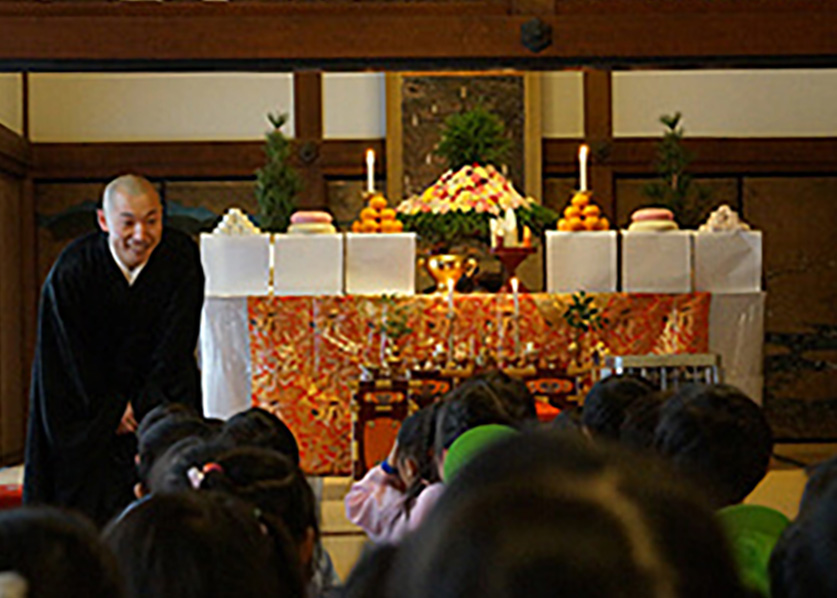
A celebration of the birth of the historic Buddha.
According to traditional accounts, the historic Buddha (Shākyamuni) was born in present-day Nepal on the 8th day of the 4th month in the year 563 B.C.E. While this was the date according to the old lunar calendar, most places throughout the Buddhist world celebrate his birth on April 8 of the modern, Gregorian calendar. More popularly known as the Hanamatsuri 花祭り or Flower Festival, the celebration at Kōyasan is called the Busshō-e.
The services at the Ōhiroma of Kongōbuji Temple feature a chanted homily narrating the events in the life of the Buddha followed by the sprinkling of a sweet hydrangea tea (called "amacha") over an image of Shākyamuni at his birth – when he is believed to have immediately stood and pointed to the heavens. The ritual anointment of the image derives from the enthronement ceremony for Indian kings. It is called the Kanboku 灌沐 ("washing of the hair"), which gives rise to yet another alternative name for the service, the Kanbutsu-e 灌仏会.

A celebration and thanksgiving for the Dual Mandala
Two mandala are central to the rites and sacred iconography of Shingon Esoteric Buddhism. These are the Kongōkai (Diamond Realm) and Taizōkai (Womb Realm) Mandala (mutually known as the Dual Mandala). It is believed that the contemplation of these visual representations of the Buddhist cosmos enables a practitioner to approach his or her essential mind and immanent Buddha nature. Not surprisingly, these mandala feature prominently in many of the most important events on the liturgical calendar at Kōyasan. One of these is the Daimandara-ku, which literally means the Adoration of the Great Mandala.
This ceremony features a circuitous procession around the Danjō-garan, from the Daie-dō to the Kondō, where the assembled priests chant sutras and prayers before the two mandala. The gold embroidered robes worn by the high ranking priests, which include the Hōin (chief ceremonial priest), make this a particularly colorful event.

One of two annual dedication ceremonies for devotional lanterns
Even a casual visitor to Kōyasan is sure to notice the large number of golden lanterns hanging from the eaves and the ceilings of many temples. The largest assembly of these devotional lamps is found at the Tōrōdō Lantern Hall standing before the mausoleum of Kōbō Daishi. The custom of dedicating a lantern here goes back to the early 11th century and continues to this day. Individuals can donate a lantern in memory of deceased loved one. The light from the lantern is believed to help guide the departed in the afterlife. Twice a year, in spring and autumn, services are conducted to commemorate the lanterns.
While the April 21 observance is held for only one day, the October edition is conducted over three nights. In each, the Hōin (chief ceremonial priest) presides over prayers and presentations at the Tōrōdō. This is preceded by a colorful procession in which lanterns to be dedicated are carried to the hall. Visitors are welcome to observe from the outer sanctum but are also reminded that photography is prohibited.
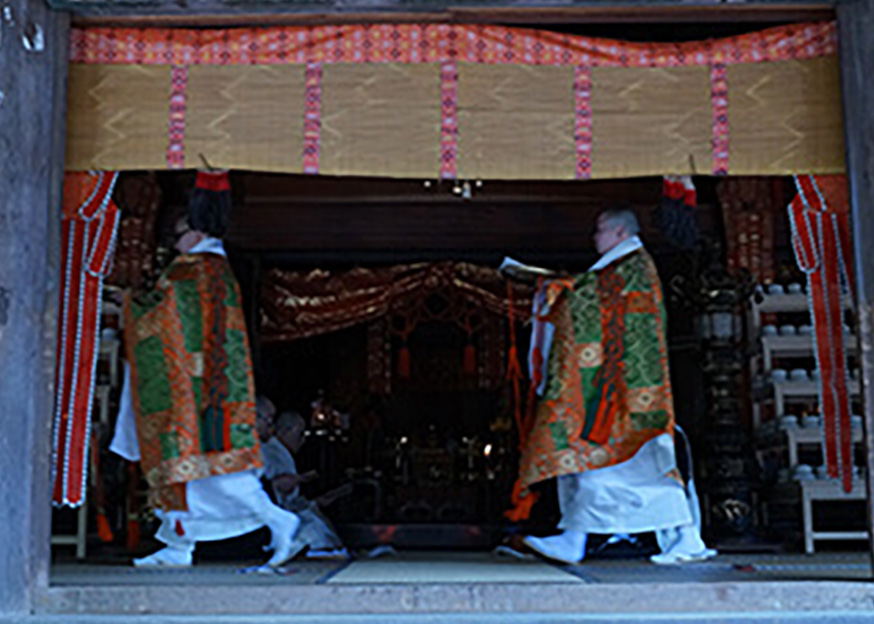
A celebration of the anniversary of Kūkai's passage into eternal meditation.
According to the old Japanese lunar calendar, Kūkai (the founder of Kōyasan) passed away on the 21st day of the third month in the year 835. At Kōyasan, his passing is observed twice annually – once on March 21 and again on the day of the modern calendar corresponding to the lunar calendar date. The first of these celebrations is called the Shōmieku; the second is the Kyū-shōmieku. Each event centers on the presentation of new robes to Kūkai, who is believed not to have died but to have entered into a state of perpetual meditation called nyūjō 入定. (See the entries for the Shōmieku and the Gyo-i Kaji for further details.)
In conformity with the lunar calendar, in which days began at sunset, the Kyū-shōmieku begins at dusk on the evening before the 21st day of the third month of the Japanese lunar calendar with a ceremony known as the O-taiya hōe 御逮夜法会. To mark the special nature of the occasion, the Danjō Garan is festooned with floral displays and bathed in the light from hundreds of candles. The doors to many of the smaller shrines are opened and their interiors illuminated, allowing visitors a rare glimpse inside. The center of the festivities is the Miedō, or "Hall of the Blessed Image," where a sacred painting of Kūkai is permanently housed and where the newest set of offertory robes was enshrined for most of the previous year. Inside the Miedō, yet visible and audible through the opened shutters, the assembled priests chant prayers and sutras. At the conclusion, the Chief Ceremonial Priest, or Hōin, departs followed by most of the others. Next, the remaining priests invite anyone in attendance who wishes to enter the Miedō to approach the sacred image of Kūkai. It is the one and only time of the year when ordinary laypersons are allowed inside. (To regulate the number of those entering, visitors are asked to first obtain a control ticket – or 整理券 "seiri-ken" – from a nearby tent.) After processing past paintings of Kūkai's earliest disciples, visitors may kneel and offer incense at an altar standing before the innermost sanctuary where the famous portrait of the founder remains shrouded in darkness. At 9:00 AM on the following day, an offertory service is conducted at the Tōrōdō of Oku-no-in. The service is presided over by the Hōin dressed in his scarlet brocade robes. At 1:00 PM, he presides over another service at the Miedō, but this time he wears the more drab colored robes of Kūkai himself. The symbolic imitation of the great founder is similarly expressed by the means in which the Hōin is transported to the Danjō Garan – carried in a palanquin modeled after the one used to convey Kūkai to this final resting place. Throughout the afternoon, various activities are conducted outside the Miedō. Of particular note is the preparation of tea and a floral arrangement, performed, respectively, by two celebrated masters of these traditional arts. These works are given as offerings to Kūkai and transported with great ceremony between the Miedō and the nearby Kondō.

An important rite of initiation conducted during two three-day periods at Kōyasan's Kondō, or Golden Hall.
The kechien kanjō, which is based on a ritual administered to Kūkai by his Master Hui Kuo, is the most important Shingon rite of initiation open to ordinary laypersons. Through the various elements of the ceremony, participants are purified and establish a spiritual connection with a Buddha from whom wisdom and guidance will be received. The rite is conducted twice a year, in early May and early October. The spring observance employs the Taizōkai (Womb Realm) mandala, while the spring observance uses the Kongōkai (Diamon Realm) mandala.
After a brief lecture and the recitation of prayers, participants are sprinkled with water, symbolic of the Five Wisdoms that arise in a mind that has been purified of distractions. They are then taught a mantra and shown how to make a mudra which they will maintain while holding a sprig of shikimi (star anise) between their fingers. Next, they are blindfolded and taken behind a curtain into the central altar where a mandala is spread out on a platform before them. On a signal from an accompanying priest, the flower is released and the initiate is told which Buddha his or her flower has fallen upon. In this way, a connection is formed between the participant and one of the Buddhas of the mandala. The kechien kanjō is offered to all members of the general public and should not be confused with the rite of initiation administered to those entering into the Buddhist priesthood. Those interested in receiving the kechien kanjō initiation can reserve a place in advance (¥5,000) or on the day of the ceremony (¥7,000). Tickets are usually made available a few months prior and can be purchased online or at various locations around Kōyasan.

A remembrance of those who died in the Second World War
The hostilities leading up to and including the Pacific War (1941-1945) resulted in millions of deaths, both military and civilian. These victims of the war (presumably from all sides) are remembered annually at Kōyasan with services at the Kondō on the second Sunday in May.
The service begins with a procession starting from the Daiedō. Paper flowers, stylized as "scattered blossoms," are strewn as the procession makes its way to the Kondō, where an offertory service is conducted. The Japanese word for scattered blossoms is "sange (散華)," and it is used as a euphemism for death in battle.

A collective memorial service for all who are interred at Kōyasan.
For centuries, bones and the relics of the deceased have been enshrined at Oku-no-in. The practice continues to the present, with new interments throughout the year. The Collective Service for the Relief of the Dead at the Inner Sanctuary of Oku-no-in is a ceremony for the presentation of prayers and offerings for all those laid to rest "at the knees" of Kōbō Daishi during the previous 12-month period. The term "gaki," appearing in the Japanese name for this service, is written with the characters that mean hungry ghost 餓鬼 and refers to the souls believed to reside in a transitional realm between life and rebirth – a kind of Buddhist purgatory, if you will. Some believe that it is incumbent upon surviving family members to provide offerings of food and prayers in order to lead these suffering spirits to their next incarnation.
The services at the altar inside the Tōrōdō, which is limited to members of the clergy, conclude with prayers before the ossuary ("nōkotsu-dō" 納骨堂) located behind the hall to the left of Kōbō Daishi's mausoleum.

Preliminary celebrations on the evening before the Aoba-matsuri
The birth of Kūkai, the founder of Kōyasan, is celebrated annually at Kōyasan with a series of events in June. The most elaborate of these is the "Aoba-matsuri" (literally, the "Festival of Young Leaves").
As its name suggests, the Eve of the Aoba-matsuri takes place on the day before the principal celebrations. These preliminary events feature a parade of illuminated "nebuta" floats beginning at 4:00 PM and followed by a twilight concert in front of Kongōbuji Temple (weather permitting).
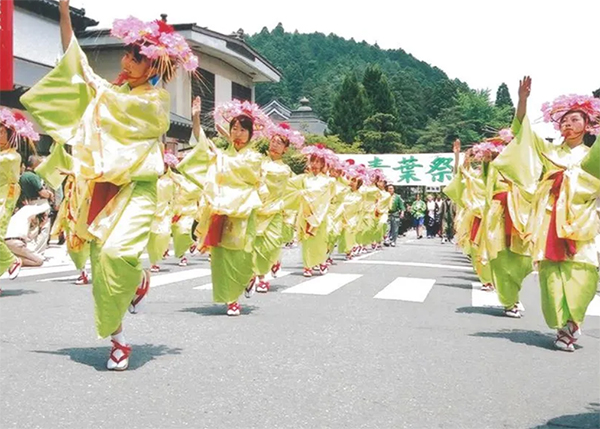
A series of celebrations commemorating the birth of the founder of Kōyasan
The traditional date for the birth of Kūkai, the founder of Kōyasan, is the fifteenth day of the sixth month of the old, lunar calendar. This date is most likely legendary, having been selected to coincide with the death of Fukū Kongō (Amoghavajra; 707-774), the Sixth Patriarch of Esoteric Buddhism. The earliest mention of a ceremony at Kōyasan to celebrate Kūkai's birth comes from the year 1778 and states that it was originally held at the Kondō. Modern observations of this auspicious event, which are held at various locations throughout Japan, are typically conducted on June 15 (or, alternatively, on the second Sunday of that month). At Kōyasan, the occasion is marked with a series of colorful celebrations known as the "Aoba-matsuri," or "Festival of Young Leaves."
Formally known as the "Gōtan-e Hōe," the Aoba-matsuri is conducted by an organization of local residents and civic groups. Unlike more solemn and stately religious ceremonies at Kōyasan, this festival is characterized by a more participatory, pageant-like atmosphere. The festivities include parades, concerts, dance performances, exhibitions of calligraphy and paintings, as well as recitals of poetry at venues throughout the town. Celebrations begin at 9:00 AM with musical performances in the square before Kongōbuji Temple. A highlight of the festivities is the "Hanamidō togyo," which begins at noon from both the Ichi-no-hashi Bridge and the Senju-in intersection. In this procession, four young local women (called the "Aoba-musume") are borne through the street on a portable shrine (the Hanamidō) from which they toss pieces of illustrated paper to onlookers. Known as "sange," these colorful strips of paper are meant to represent lotus blossoms. This parade is followed by a speech from the mayor and the distribution of rice cakes (o-mochi) in the square before Kongōbuji Temple.

An Oral Examination for Shingon Priests
Originally held over a ten-day period, but now conducted in only two, the Uchidangi, or "Private Colloquy," is one of many ritual gatherings at Kōyasan for the assessment and promotion of Shingon priests. Specifically it is the penultimate stage in the advancement to the rank of jōgo, which is one of the highest echelons within the Shingon ecclesiastical order (comparable to that of bishop or cardinal in Roman Catholicism).
The event takes the form of an oral discussion in which candidates for advancement are questioned on Buddhist scriptures and commentaries. Both answers and responses are made in a characteristic chant known as shōmyō (Skt: śabda-vidyā) which uses the pentatonic scale heard in early court music (gagaku). The language used is that of early medieval period Japanese featuring inflections no longer used in the modern language. (An English equivalent would be the requirement that an oral exam be conducted using archaic verb forms like "hast," "doth" and "goeth.") While the public is able to listen at a distance, the proceedings are carried out behind bamboo blinds and cannot be witnessed directly; however, visitors to Kongōbuji may be able to catch a glimpse of the participants and various attendants as they process to the temple for the 10:00 AM start. To mark the occasion, special floral arrangements known as godan-ka (or five-tiered flowers) prepared by Kōyasan ikebana masters are displayed at various locations.
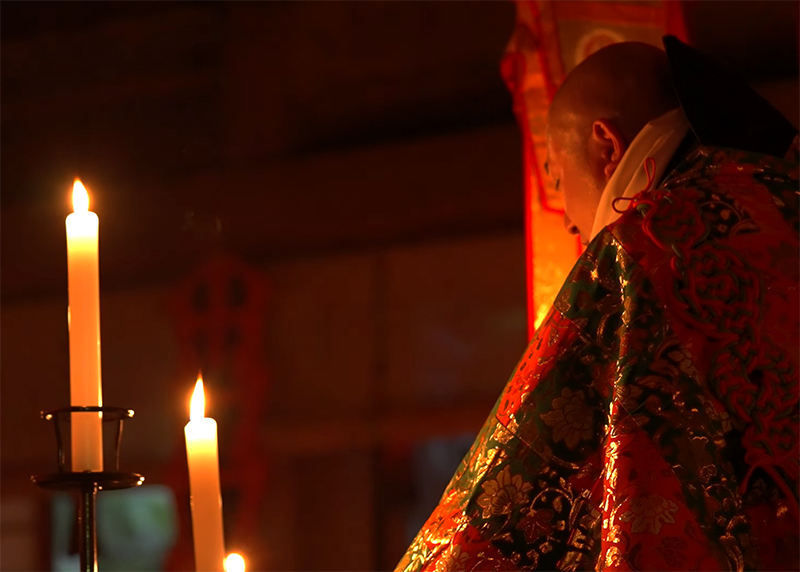
An Oral Examination for Shingon Priests
The Mi-Saishōkō, which began as ritual conducted at the imperial palace for the peace and tranquility of the nation, has been observed on Kōyasan since the late 12th century. Originally, this featured lectures and discussion on the Golden Light Sutra. This important sutra, which promises the protection of the Four Heavenly Kings to all those who recite it, was a favorite among East Asian rulers. The name Mi-Saishōkō is taken from the Japanese translation of the full title: Konkō myō saishō ō gyō, or The Sovereign King of Sutras, the Sublime Golden Light. Since the 13th century, the Mi-Saishōkō, or "Disquisition on the Golden Light Sutra," has featured a formal discussion in question and answer format. The length of the services has been reduced from ten sessions over a five-day period to just four over a two-day span and the texts that were once memorized are now chanted from a book. Imperial representatives are no longer dispatched from the capital to attend.
Despite many changes, the Mi-Saishōkō remains a rigorous and solemn proceeding, the successful completion of which is the final stage in the promotion of its officiants to the rank of jōgo. This is the highest echelon within the Shingon ecclesiastical order. The Mi-Saishōkō is held throughout the night on the eleventh and twelfth days of the sixth month of the lunar calendar. It takes place at the Sannō-in at the Danjō Garan which stands before the shrine of the mountain deities. After a procession of the participants from Kongōbuji Temple, the discussion begins at dusk on each of the two days and continues until the morning. Visitors can watch from the verandah of the hall.

This is a memorial service for all deceased Japanese emperors.
Since the late seventh century, Buddhist memorial services have been conducted for departed emperors. (Similar practices can be found in China and Korea.) The custom was to perform these services for an individual emperor at a Buddhist temple on the anniversary of the emperor's death.
The annual service at Kōyasan is a collective service for the successive generations of emperors. The earliest record of such a service here at Kōyasan was for Emperor Godaigo (1288 – 1339) – the imperial patron who commissioned the establishment of the nearby Aizendō. The conduct of Buddhist rites for Japanese emperors (the Chief Ritualist for the indigenous Shinto faith) reminds us of the close historical relations between these two religions. Shingon in particular rose in prestige during its early period due to its performance of many rituals for the health and safety of the emperor.

A remembrance for thousands who perished in 1923.
Just before noon, on September 1, 1923, a 7.9 magnitude earthquake struck Japan's Kanto plain causing massive devastation to Tokyo, Yokohama and the surrounding area. The earthquake and the fires that quickly spread claimed more than 100,000 lives. Adding to the tragedy, thousands of Koreans (as well as Chinese and Japanese who were mistaken as Korean) were killed in a subsequent massacre fueled by xenophobia.
The anniversary of the earthquake is marked at Kōyasan with a memorial service at the cenotaph for the disaster. The enshrinement registry for the cenotaph records the names of more than 50,000 victims, including three members of the imperial family and more than 200 non-Japanese. The cenotaph, which is located near the Ichi-no-hashi bridge, was erected by Nagata Hidejirō (1876 -1943), who served as mayor of Tokyo. Nagata's own gravestone is located nearby.

Marking the anniversary of Shinzen's death.
As the nephew and successor of Kūkai, the founder of Kōyasan, the priest Shinzen (804? - 891)oversaw for more than 50 years the completion of many of the first temple structures after the death of his uncle. He also instituted an important training program for monks in order to preserve and transmit Kūkai's teachings.
This memorial service, which is conducted as a celebration and thanksgiving for Shinzen's contributions, is held on the grounds of Kongōbuji Temple, in the area before Shinzen's mausoleum. The name of the service employs Shinzen's honorific title.

Equinoctial service for the dead.
In addition to New Years and the summer Obon season, Buddhist services for the dead are observed by the Japanese in the days before and after the spring and autumn equinoxes, each of which is a national holiday. Known as Higan (or sometimes O-higan), this one of the main times of the year for people to pay respects at the family grave. The name higan literally means "distant shore," a reference to the world beyond our earthly existence.
Sutras and prayers are recited for the remission of sins and the remebrance of good deeds.

A ritual blessing of sand and earth
The Mantra of Light (kōmyō shingon, 光明真言), set forth in an esoteric Buddhist sutra, was used since the Heian period in a ritual incantation performed to release the spirits of the dead from suffering and attain liberation and rebirth in the Pure Land of Amida (Amitabha). Pure sand, blessed through the mystical power of the mantra, was sprinkled on the body or grave of the deceased.
In this service, held during the autumn equinox, the Mantra of Light ("Om abogya beiroshanō makabodara mani handoma jinbara harabari tayaun") is recited 108 times over a mixture of sand and earth. Portions are then divided into folded paper and distributed to those in attendance (presumably for them to sprinkle on the grave of a deceased relative).
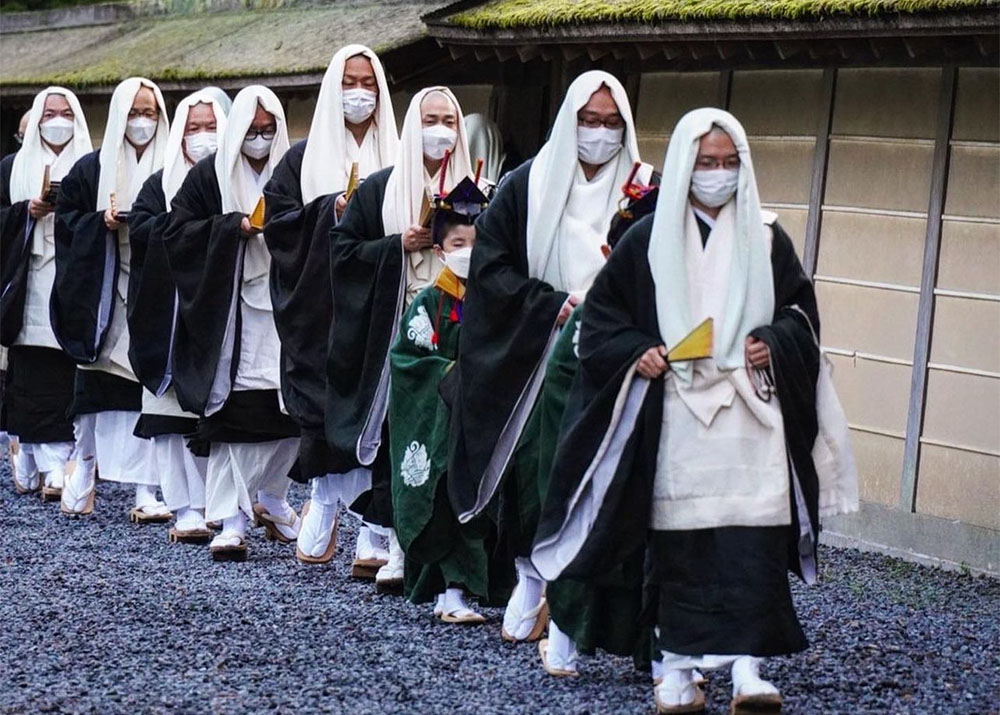
A private educational program for Shingon clergy.
This event, which is held over 10-day period in September, is part of the years-long education and accreditation process for the Shingon clergy. The instruction focuses on a knowledge of proper ritual and ceremonial customs as well as an understanding of various Buddhist scriptures, including the works of Kūkai. The training concludes with two days of sequestration followed by oral examinations at the Kangaku-in
As it is closed to the public, the best a non-participant can hope for is a glimpse of the priests as they march together to the Kangaku-in in the early morning or perhaps as they pray before various temples around the monastic complex. A visitor who is up before 6:00 AM may see them in dark robes with white head coverings accompanied by a young acolyte.

An important rite of initiation conducted during two three-day periods at Kōyasan's Kondō, or Golden Hall.
The kechien kanjō, which is based on a ritual administered to Kūkai by his Master Hui Kuo, is the most important Shingon rite of initiation open to ordinary laypersons. Through the various elements of the ceremony, participants are purified and establish a spiritual connection with a Buddha from whom wisdom and guidance will be received. The rite is conducted twice a year, in early May and early October. The autumn observance employs the Kongōkai (Diamond Realm) mandala, while the spring observance uses the Taizōkai (Womb Realm) mandala.
After a brief lecture and the recitation of prayers, participants are sprinkled with water, symbolic of the Five Wisdoms that arise in a mind that has been purified of distractions. They are then taught a mantra and shown how to make a mudra which they will maintain while holding a sprig of shikimi (star anise) between their fingers. Next, they are blindfolded and taken behind a curtain into the central altar where a mandala is spread out on a platform before them. On a signal from an accompanying priest, the flower is released and the initiate is told which Buddha his or her flower has fallen upon. In this way, a connection is formed between the participant and one of the Buddhas of the mandala. The kechien kanjō is offered to all members of the general public and should not be confused with the rite of initiation administered to those entering into the Buddhist priesthood. Those interested in receiving the kechien kanjō initiation can reserve a place in advance (¥5,000) or on the day of the ceremony (¥7,000). Tickets are usually made available a few months prior and can be purchased online or at various locations around Kōyasan.

Dedication service for devotional lanterns before the mausoleum of Kōbō Daishi.
Golden lanterns, known as tōrō, are ubiquitous at Kōyasan, most prominently at the Tōrōdō or "Lantern Hall" standing before the mausoleum of Kōbō Daishi. These lanterns are associated with the eternal light of Dainichi Nyorai, the Great Sun Buddha and central Shingon object of veneration. The donation of these devotional lantern dates back centuries and has been practiced by emperors and ordinary citizens alike.
The Oku-no-in Mandō-e, which is held for three evenings in both April and October, is one of the few Kōyasan ceremonies held at night. Donated lanterns are offered along with prayers and wishes. In addition to the brilliance of the lanterns themselves, the pageantry is made especially colorful by the brocade robes of the numerous clergy in attendance. Services are led by the Hōin – the "Dharma Seal," the chief priest of the sect. While enjoying the spectacle, please remember that it takes place in an area of the sacred mountain where photography is strictly prohibited.

A celebration in honor of the tutelary Shinto gods of the mountain.
According to a popular legend concerning the foundation of Kōyasan, Kūkai was assisted by two local deities. The first, known as Kariba Myōjin, appeared to Kūkai as a hunter with two dogs who helped guide him to a suitable location. The other was Kariba's mother, a goddess named Nuitsuhime, who revealed herself to Kūkai when he spent a night at a shrine located along the route. Nuitsuhime welcomed Kūkai and his plan to establish a Shingon monastery on her mountain. In gratitude. Kūkai promised to build both deities a sanctuary on the grounds of his temple where he would reverently worship them as the tutelary gods of the mountain. That shrine, the Miyashiro (or Myōjinja), is located at the western end of the Danjō Garan.
After a Buddhist service before the Shinto sanctuaries where Niutsuhime and Kariba Myōjin are enshrined, a mikoshi (a portable Shinto tabernacle) made by middle school students is paraded through the town. Along the way, priests toss rice cakes (o-mochi) to all those gathered to watch.

A celebration of Emperor Daigo's conferral of the title Kōbō Daishi to the founder of Kōyasan.
In Japan, as in other Asian countries, it is traditional to confer a posthumous title to a deceased individual in recognition of his or her achievements. For Buddhist priests in Japan, beginning with Saichō (766-822) in the year 866, the most illustrious title has been that of Daishi 大師 or "Great Teacher." In 921, 86 years after his death, Kūkai was given the name Kōbō Daishi by Emperor Daigo (885-930; r. 897-930). The award of this title, which means "Great Teacher who Widely Expounds the Buddhist Dharma," was in response to a petition from one of Kūkai's successors. While Kūkai was not the first to receive this honor, he has become the historical figure most closely associated with the title, so much so that the word Daishi is now synonymous with Kūkai.
The Shigō Hōsan-e service, observed on the anniversary of the conferral of Kūkai's posthumous title, is officiated by the outgoing Hōin (ceremonial head priest) as one of his final official duties. The ceremony is preceded and concludes with a procession of priests from the Lantern Hall across the Gobyō-bashi Bridge.

A torch-lit procession and presentation of a large sacred Shinto wand before the shrine to gods of the mountain.
The arrival of the new year is one of the most important times for the Japanese. The season is accompanied by many ritual observances, many of which are intended to purify oneself from sin and promote spiritual renewal. The Gohei osame, is an interesting illustration of Shinto-Buddhist syncretism in which Buddhist priests from Buddhist Ryūkō-in temple make a ritual offering to the deities of a Shinto shrine on the last night of the year. Ryūkō-in is the temple where Kūkai resided at Kōyasan. It was known as Chū-in, or the Central Temple, at that time.
Before midnight on New Year's Eve, the priests of Ryūkō-in, located just to the north of the Danjō Garan, carry a large Shinto wand (gohei) made of bundled strips of sacred paper. Led by a huge torch, the procession makes its way to the Miyashiro shrine at the western end of the Danjō Garan where the wand is presented to the tutelary deities of the mountain. Observers might want to remain at the Garan to watch the Joya-no-kane, the tolling of the midnight bell, to mark the start of the New Year. Traditionally, the bell is struck 108 times, one for each of the obstacles that must be overcome on the path to enlightenment. This custom is observed at most temples throughout Japan.
© 2025, k. collins